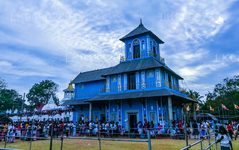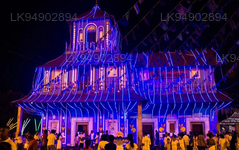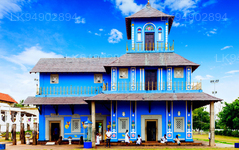
Safari en Kandy
Kandy, una pintoresca ciudad en el centro de Sri Lanka, es famosa por su rico patrimonio cultural, sus vibrantes festivales y su belleza paisajística. Enclavada entre exuberantes colinas, alberga el Templo de la Reliquia del Diente, declarado Patrimonio de la Humanidad por la UNESCO, y ofrece una cautivadora combinación de historia y esplendor natural.
Maha Vishnu Devalaya
On to the North-West of the palace, in front of the “Natha Devale“ is the “Vishnu Devalya” popularly a the “Maha Devale”. This is one of the Hatara Devale in the Kandy, the other three being the Natha, Kataragama and Patini. These four Devalayas have a long association with the Royal Palace ( Maha Vasala) and the Temple of Tooth Relic (Sri Dalada Maligawa) and has been venerated by Buddhists and Hindus alike from the inception.
Different historical documents have called this deity and the Devale by different names. Robert Knox, the English Prisoner has called the deity in this devale “Aluth Nuwara Deiyo”. According to legend the “Aluth Nuwara Deviyo” was brought to Aluth Nuwara in Kegalle District from Devinuwara in Matara. This deity was called “Upulvan Deiyo” (deity with a colour of a lotus). Later this deity in Aluth Nuwara was known as “Vishnu”. The 15th century “Paravi Sandeshaya”, a poetical work describes the deity at Devinuwara, Matara as a destroyer of Asura. Thus it can believed that this same deity is also “Rama” of the great Indian Epic “Ramayana”. Interestingly “Ehelapola Varnanawa”, a poetical work done in the 19th century calls this shrine at Kandy, “The Rama Devale”. It is also interesting to note that this devale has had in possesion a cloth painting depicting the Battle of Rama and Rawana.
“According to Mahavansa, The great chronicle of Sri Lanka, It was “Upulvan Deiyo” thus Vishnu that was selected as the guardian to protect the land of Sri Lanka and Buddhism within it at the time of Buddha’s passing away.
“When the Guide of the World, having accomplished the salvation of the whole world and having reached the utmost stage of blissful rest, was lying on the bed of his nibbana; in the midst of the great assembly of gods, he, the great sage, the greatest of those who have speech, spoke to Sakka’ who stood there near him: `Vijaya, son of king Sihabahu, is come to Lanka from the country of Lala, together with seven hundred followers. In Lanka, O lord of gods, will my religion be established, therefore carefully protect him with his followers and Lanka.
When the lord of gods heard the words of the Buddha he from respect handed over the guardianship of Lanka to the god who is in colour like the lotus.
According to beliefs, Vishnu is a future Buddha after Natha. Therefore Vishnu always has had a high ranking within the deities worshipped by the Sri Lankans. During the Kandyan Era the the Kings “Abisheka Mangallaya” or the Coronation Ceremony was held at this Maha Devale.
The origin of Vishnu Devalya or the shrine of Vishnu is unclear. This is a long building with a storied sanctum at the end. In front the sanctum is a long hall called “dig-ge”. This hall is for dancers and who carry out puja for the deity. Today it is used by the devotees to pray. This building complex is entered through a two storeyed Vahalkada (entrance doorway), to an open hall with timber columns in the middle terrace, a beautifully carved stone flight of steps and the drumming hall. On the upper terrace is another small shrine, the God Dedimunda’s Shrine and a large Bo-tree.
Acerca del distrito de Kandy
El distrito de Kandy está situado en la provincia central de Sri Lanka. Kandy, uno de los siete sitios declarados Patrimonio de la Humanidad en Sri Lanka, fue en el siglo XVI el hogar de los antiguos reyes kandyanos y una fuente de toda la música, las artes, la artesanía y la cultura del país. A unos 129 km de Colombo, Kandy está enclavada en un terreno montañoso y todas las miradas se dirigen al centro de la ciudad, donde el lago Kandy forma un elemento encantador. Kandy conserva un gran significado religioso para Sri Lanka, ya que en esta encantadora ciudad se encuentra el Dalada Maligawa o "Templo del Diente", en cuyo interior se encuentra bien custodiada la reliquia sagrada del diente de Buda.
El Real Jardín Botánico de Peradeniya se encuentra a unos 5 km al oeste del centro de la ciudad y recibe la visita de 1,2 millones de personas al año. Es el jardín botánico más grande de la isla. El Udawatta Kele (Bosque Udawatta) es un santuario protegido situado en el corazón de la ciudad, justo al norte del Templo del Diente. Kandy es una ciudad de mayoría cingalesa; existen importantes comunidades pertenecientes a otros grupos étnicos, como moros y tamiles. Kandy es, después de Colombo, el centro de la economía de Sri Lanka. Muchas importantes empresas tienen grandes sucursales en Kandy, y aquí se encuentran numerosas industrias, como la textil, la del mueble, la informática y la joyería. Numerosos centros de investigación agrícola se encuentran en la ciudad.
Y fuente de toda la música, las artes, la artesanía y la cultura del país. A unos 129 km de Colombo, Kandy se encuentra enclavada en un terreno montañoso y todas las miradas se dirigen al centro de la ciudad, donde el lago Kandy forma un encantador paisaje. Kandy conserva una gran importancia religiosa para Sri Lanka, ya que en esta encantadora ciudad se encuentra el Dalada Maligawa o Templo del Diente, donde se custodia la reliquia sagrada del diente de Buda.
Acerca de la Provincia Central
La Provincia Central de Sri Lanka se compone principalmente de terreno montañoso. Tiene una superficie de 5.674 km² y una población de 2.421.148 habitantes. Algunas de sus ciudades principales son Kandy, Gampola (24.730), Nuwara Eliya y Bandarawela. La población es una mezcla de cingaleses, tamiles y moros.
Tanto Kandy, la capital de la montaña, como Nuwara Eliya se encuentran en la Provincia Central, al igual que Sri Pada. La provincia produce gran parte del famoso té de Ceilán, plantado por los británicos en la década de 1860 tras una devastadora enfermedad que destruyó todas las plantaciones de café de la provincia. La Provincia Central atrae a numerosos turistas, con pueblos en las colinas como Kandy, Gampola, Hatton y Nuwara Eliya. El Templo del Diente o Dalada Maligawa es el principal lugar sagrado de la provincia Central.
El clima es fresco, y muchas zonas a unos 1500 metros de altitud suelen tener noches frías. Las laderas occidentales son muy húmedas, con casi 7000 mm de lluvia al año en algunos lugares. Las laderas orientales forman parte de la zona semiseca, ya que solo reciben lluvias del monzón del noreste. Las temperaturas oscilan entre los 24 °C en Kandy y tan solo 16 °C en Nuwara Eliya, situada a 1889 m sobre el nivel del mar. Las montañas más altas de Sri Lanka se encuentran en la Provincia Central. El terreno es mayoritariamente montañoso, con profundos valles que lo atraviesan. Las dos principales regiones montañosas son el macizo central y la cordillera Knuckles, al este de Kandy.


























